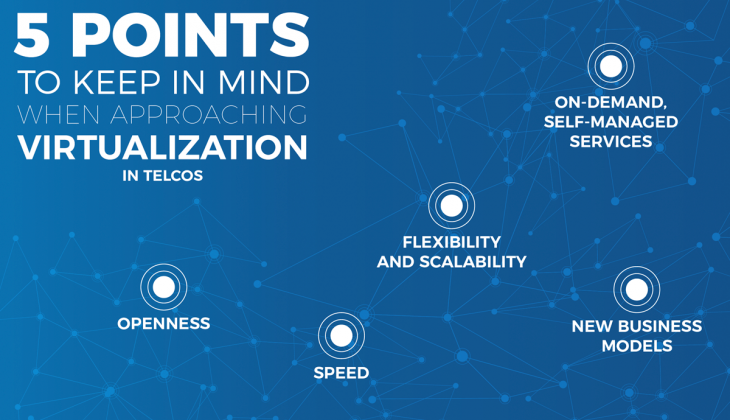For Telcos, Virtualization in Telecoms is the Key to B2B Success
- Published
- 5 min reading

Bigger is best? Tell that to the dinosaurs, massive ungainly creatures who were ultimately replaced by smaller, faster, smarter and more adaptable beings as the dominant creatures on Earth. Similar could be said of the telecommunications industry, which is witnessing the death throes of soon to be extinct cumbersome physical monoliths, and the rapid evolution of virtualization.
Telcos can reap the rewards of B2B cooperation by evolving rapidly towards virtualization
End-users of digital mobile services have become more tech-savvy, demanding and canny. They are all too aware of the “best deal” and can switch relatively easily between providers to secure it. B2C commerce, dealing direct with consumers, has therefore become a highly saturated market in which it is difficult for any one company to extend their reach significantly.
The Business-to-business sector, on the other hand, is ripe for development – which is where virtualization and the cloud have already shown their value. These technologies embody an approach that lets CSPs dealing with enterprise customers offer comprehensive, flexible and scalable services quickly, all in one package.
Specifically, software-defined networking has removed barriers associated with inflexible proprietary systems by employing protocols such as OpenFlow, while network function virtualization has facilitated the replacement of physical network elements with software capable of running on generic servers. At the same time, cloud computing has cut the need for physical storage and operational space.
The result is that virtual services and cloud computing are becoming the norm, and CSPs that have already realized this and embraced these technologies have placed themselves right at the head of an increasingly competitive telecommunications market. They are reaping the rewards of adopting SDN/NFV and the cloud to develop robust partnerships with many industry verticals.
To be successful in this digital evolutionary process, telcos need to approach virtualization with a five-point plan in mind. These points encompass openness, flexibility and scalability, on-demand, self-managed services, speed, and new business models. Let’s take a look at each of those in turn.

5 factors that will influence the success of virtualization in telecoms for B2B (Business to Business)
Openness
There are two aspects to this. One is about being open-minded towards new technologies and willing to adopt them. The other is about the way in which virtualization technologies work. SDN/NFV are by their nature open – they literally throw out the “proprietary” rulebook and replace it with open network protocols, making it possible for telcos to offer services based on fairly simple commercial off the self (COTS) hardware.
Flexibility and scalability
Different B2B clients need different things from their telco partner. Virtualization for telecoms, especially when combined with DevOps processes and microservices, makes it possible for them to tailor offers to specific verticals. What’s more, it’s a straightforward process to adapt current solutions should a client’s needs change, especially in terms of scaling up or back to meet permanent growth or temporary changes in demand for a given service.
On-demand, self-managed services
The flexibility and scalability of SDN/NFV and cloud computing streamlines the way that a CSP can interact with its business customers. It’s not enough that you deliver a tailored, adaptable solution to a client if they then have to wait for your input before they can take advantage of this scalability. With virtualization comes extensive automation, which means you can provide that client with a service specifically designed to react automatically to certain demands. At the same time, SDN/NFV allow you as the service provider to offer clients their own virtual “slice” of your network. In this case, a CSP will of course establish certain ground rules and protocols, but the client is free to manage their network slice as they wish.
Speed
Fast isn’t fast enough anymore – the only speed that works for clients in many verticals is near instantaneous. Virtualization for telecoms ups the pace in terms of getting services to market and running them, because it knocks out time-consuming and error-prone processes associated with monolithic networks. Again, this is where SDN/NFV combines well with the DevOps approach and microservices. DevOps promotes collaboration across a telco’s development and deployment teams, each responsible for their own microservices that are small and simple enough to be upgraded fast – even automatically – without a complete system overhaul. The result? Instantaneous everything.
New business models
Virtualization for telecoms has even changed the way that business compete and view each other across the sector divide. A lot of this is thanks to the rapid development of a “smart” world via the Internet of Things (IoT). For example, the automotive and health verticals can no longer be described as independent of the telecommunications industry in our new connected environment. For the CSP focusing on developing B2B partnerships and maximizing revenues through this route, this means establishing new business models to deal with revenue sharing, multi-billing, and so on.
These five points are the cornerstones of a successful development plan for any CSP planning to reap the rewards of B2B cooperation by evolving rapidly towards virtualization in telecoms. For those that prefer to stick with the old ways, well, there is an alternative to evolution; but historically it hasn’t worked out well for those involved…







